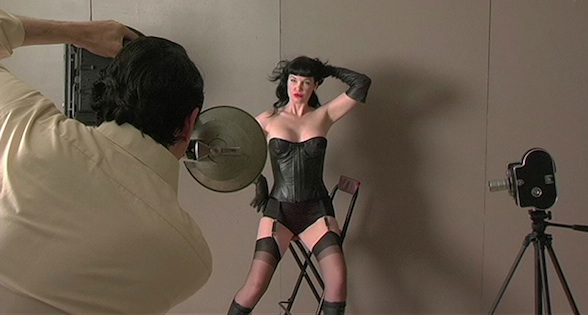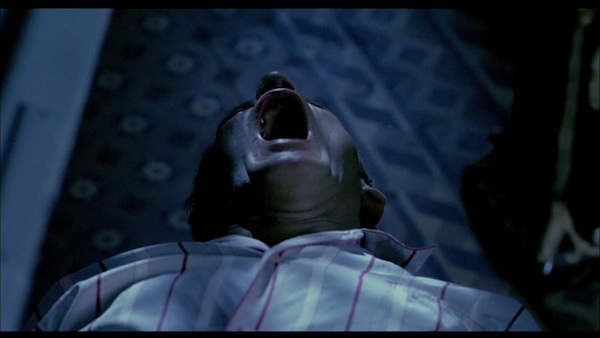Nico B is a producer, author, filmmaker and distributor who lives and breathes cult cinema. A U.S. resident since 1998, the Dutch national began distributing hard-to-find cult films on video while still in his twenties, after a film school teacher told him his own ideas were “too radical” to find financing. Today his company Cult Epics boasts a distinctive catalog of films united only by overlaps of art, exploitation and envelope-pushing themes.
A good example is Agustin Villaronga‘s 1986 Spanish thriller In a Glass Cage, about a former Nazi medical experimenter and the disturbed former victim who tracks him down for a very complicated form of revenge. Unforgettably harrowing, it’s a study in psychosexual sickness way beyond anything Hitchcock would have dared—yet executed with all the formal elegance of the “Master of Suspense” at his best.
It’s one of eight Cult Epics titles already viewable here, alongside three early, politically and artistically daring features (Attraction, Deadly Sweet, The Howl) from Italian director Tinto Brass, later known for his female-posterior-worshipping softcore films and the notorious all-star Caligula; two over-the-top 1970s exercises (Behind Convent Walls, Love Rites) from Polish animator turned eccentrically playful erotic arthouse specialist Walerian Borowczyk; Belgian Olivier Smolder‘s much more recent surreal nightmare Black Night; and Nico B.’s own sole feature to date Bettie Page Dark Angel (2004), a fond recreation of the famed 1950s American fetish model’s heyday.
There’s more to come, including documentary portraits of late literary giants Jose Luis Borges and Jean Genet (plus the latter’s widely banned 1950 film exercise Un Chant D’amour). Not to mention numerous vintage features by two great filmmakers working on the transgressive margins of 1960s through 1980s European cinema: Extravagantly stylish eroticist Radley Metzger, and Buñuel‘s pungently political/absurdist Spanish inheritor Fernando Arrabal. Even more neglected are features by Dutch iconoclast turned genre-bending U.S. feature director Rene Daalder (Massacre at Central High, Population: 1).
The Cult Epics library streaming here has just expanded via two shorts by Nico B himself—both wordless, black and white and edgy in the extreme. 1998’s Pig is a haunting exercise in graphic and surreal imagery that’s not for the squeamish, on which he collaborated with Rozz Williams. The latter’s subsequent suicide (and his friend’s sense of being haunted since) spurred the new 1334, which was years in the making.
We checked in with Nico just as he was about to travel between coasts for special in-person theatrical screenings of Pig and 1334.
Keyframe: You’ve said your own films come from the subconscious, rather than being directly inspired by anyone else. But Pig strongly connects to the 1980s ‘Cinema of Transgression’ movement in which Nick Zedd and Richard Kern were major figures. Were they an influence?
Nico B: Both kind of violate any law of filmmaking. But to me, there are basically two aspects of filmmaking. First of all, the story, which entirely comes to me subconsciously, through events and people trying to connect with me. Regarding the look of the film, I see the similarity of both being black and white, although they [Kern and Zedd] mostly shot their films on Super 8 and mine are on 16mm. I feel more connected to the European surrealistic movement of the 1930’s, their ideas and filmmaking. Also, Cinema of Transgression is related to New York and is dead; what Richard is doing now has nothing to do with then. Underground cinema is a rare thing these days.
Keyframe: Pig is the rare experimental short that seems to have found a real cult following. You made it in collaboration with Rozz Williams, the Christian Death frontman and goth icon. You’ve said your new short 1334 is an “exorcism” of sorts in that Williams haunted you and others after his 1998 suicide. Please explain.
Nico B: The new film was inspired by events that happened after Rozz’s death. I keep diaries and realized after ten years that his spirit—or in this case, in the film, his ghost—is still around. It happens to people who commit suicide, [who] don’t leave and stay around. I have had relationships with females over the years who were highly perceptible to the unexplainable. They’ve seen his spirit, in the form of a black cloud or smoke, they’ve encountered the pain and suffering of his act of suicide. By writing a script, and then making the film, I kind of exorcized him out of my mind—as well out of my house. Well, meanwhile I moved.
Keyframe: You not only distribute an array of vintage loops starring the perky 1950’s BDSM ‘gentleman’s smoker’ superstar Bettie Page, you made a feature about her. Why the lingering fascination?
Nico B: Well, it has been a while. I made Bettie Page Dark Angel in 2004, only because the star of my movie, Paige Richards, was a dead ringer. The film is also an homage to 1950s camp and kitsch, Ed Wood-type filmmaking and those original Bettie Page bondage films, which were destroyed and no longer exist. In a philosophical way it also relates to sex being a taboo in the 20th century and why filmmakers like Irving Klaw, Tinto Brass and Radley Metzger should be embraced, because there is nothing like [them] in the genre of erotic cinema.
Keyframe: You’ve said your time-consuming duties as a producer/distributor have severely cut into your ability to be creative as a filmmaker—each of your more recent directorial projects took years to complete. Is that frustrating, or do you find enough satisfaction in bringing other people’s envelope-pushing work to the public?
Nico B: I never had the ambition of becoming a known or commercial film director. Coming from the music industry, I was aware that true artists in general have a hard time surviving financially on the work they create. Some are more lucky than others. Because I had that revelation at an early age, I decided to become a producer and promoter of other people’s art, and commit to this, more than my own. But then again I can’t help myself, releasing the beast within me.
Keyframe: What attracts you to a particular film for Cult Epics release? Your taste is rather specific but hard to describe: what qualities do you feel most fascinated by in films and filmmakers?
Nico B: I never thought about this, until the moment somebody asked me this question before. I noticed that all the films I have released have an artistic sense, and they all are controversial—whether today or when originally produced.
Keyframe: Some of these films are comparatively well-known, but many others were long-forgotten and unavailable until Cult Epics took them up. Were these films simply neglected, or tangled in legal-rights issues?
Nico B: When I acquired the rights for the original Bettie Page films, no one was aware of her hardly. The same with the films of Arrabal and other directors I represent in my catalogue. Sometimes the films’ subjects or stars create a cult following.
There were films, for instance, Death Bed: The Bed that Eats (1977), which simply were never released before. By some strange circumstance a copy came to me through a journalist in the UK, as he thought of my company. When I watched the first fifteen minutes I thought it was a typical retro horror film, like something Blue Underground should release. But my patience paid off when I found out that the story was about the ghost of Aubrey Beardsley (of whose work I am a big admirer) and there were these incredible scenes–for instance, when someone gets killed in the bed, the flowers outside start to blossom red. The film became a huge success when it was released [twenty five years after its post-production wrapped]. It was compared in the press with the surreal aspect of El Topo and campiness of Pink Flamingos. The director George Barry is currently working with me on a Blu-ray version and a commentary track in which he will explain more about his vision and ideas.
One frequent issue in releasing a film is finding materials, which are not always readily available. Unlike studio films, smaller producers often don’t have them, [especially] for older films. It can take years sometimes to locate a master—which isn’t always in the best shape, but I feel it’s better than nothing–or a rare 10th-generation bootleg. This is something the audience is not aware of, [but] the effort pays of for me.
Keyframe: The movies streaming here look great, though…. Some directors highlighted by Cult Epics have passed on. But when you were releasing their films to home formats, many were still alive and kicking. Any colorful stories of dealing with them?
Nico B: Well, many are still alive. Only Borowczyk died, which is a pity as we were talking about releasing his animated as well some hard-to-get films—and without his direct involvement that is probably never going to happen. My surreal meetings with Arrabal have been documented as DVD extras for people to see, I remember the day I shot Abel Ferrara’s commentary for The Driller Killer in a very small room at the Chelsea Hotel. The person who did the audio was dealing drugs while we were recording, which eventually took three nights.
Radley Metzger is someone I’d never heard of; his films weren’t released in Europe when I was living there. I discovered his name thru Anna Biller’s cover text for [2007 vintage sexploitation satire/homage] Viva. I asked her who he was, and when I watched his films I noticed they were magnificently photographed. Camille 2000 was shot by the same cinematographer as the Oscar-winning The Garden of the Finzi-Continis a year later. I called, then met with him in New York. He shared stories of people he’d met, like Arrabal and Genet. It felt like meeting an old friend, although we’re nearly 40 years apart [in age]. When he told me the rights expired at First Run, I started restoring his films, which have now been shown at the UCLA/Hammer Museum and other arthouses in their new versions.
Keyframe: You’ve brought renewed attention/exposure to some seriously neglected international directors. In that vein, what releases are you proudest of?
Nico B: All of them. The films come to me for some reason or another. I don’t go to film markets to find films, unless I have to meet a producer for a film the director has made me aware of.
Keyframe: What’s on your wish list of rare films you’d like to acquire/distribute?
Nico B: I don’t know, I never had one. There are some films I’ve seen recently I would love to release—for instance Three Steps Above Heaven, the most popular Spanish film of 2010, but rare here as it has not been released on video. Last October I was at a film festival in Oldenburg and saw a film called Zero Killed, which I was scared of, and afraid to release. But when I met the director, he changed my mind. It’s coming out on video in June.
I am currently also working on a couple of Blu-ray/DVD releases of Rene Daalder—which has taken me years—including Hysteria and hopefully Massacre at Central High [to be released] sooner [rather] than later. I am hoping to release Agusti Villaronga’s 1989 Moon Child, whose soundtrack was scored by Dead Can Dance. Again, it takes time. For instance his In a Glass Cage took eight years before I finally got the deal, and has now been re-issued twice by Cult Epics. It was only recently that a new HD transfer could be made. Due to the film’s subject matter and controversy, the negative print was held by the [Spanish] government, and only released once in 15 years’ time.






